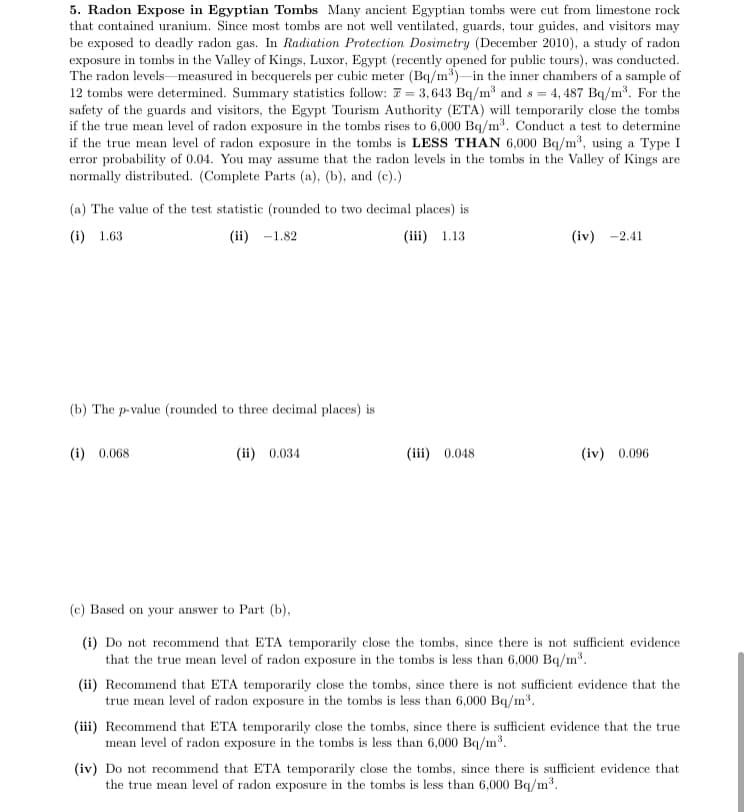5. Radon Expose in Egyptian Tombs Many ancient Egyptian tombs were cut from limestone rock that contained uranium. Since most tombs are not well ventilated, guards, tour guides, and visitors may be exposed to deadly radon gas. In Radiation Protection Dosimetry (December 2010), a study of radon exposure in tombs in the Valley of Kings, Luxor, Egypt (recently opened for public tours), was conducted. The radon levelsmeasured in becquerels per cubic meter (Bq/m*)-in the inner chambers of a sample of 12 tombs were determined. Summary statistics follow: T = 3,643 Bq/m3 and s = 4, 487 Bq/m. For the safety of the guards and visitors, the Egypt Tourism Authority (ETA) will temporarily close the tombs if the true mean level of radon exposure in the tombs rises to 6,000 Bq/m³. Conduct a test to determine if the true mean level of radon exposure in the tombs is LESS THAN 6,000 Bq/m, using a Type I error probability of 0.04. You may assume that the radon levels in the tombs in the Valley of Kings are normally distributed. (Complete Parts (a), (b), and (c).) (a) The value of the test statistic (rounded to two decimal places) is (i) 1.63 (ii) -1.82 (iii) 1.13 (iv) -2.41 (b) The p-value (rounded to three decimal places) is (i) 0.068 (ii) 0.034 (iii) 0.048 (iv) 0.096 (c) Based on your answer to Part (b), (i) Do not recommend that ETA temporarily close the tombs, since there is not sufficient evidence that the true mean level of radon exposure in the tombs is less than 6,000 Bq/m. (ii) Recommend that ETA temporarily close the tombs, since there is not sufficient evidence that the true mean level of radon exposure in the tombs is less than 6,000 Bq/m3. (iii) Recommend that ETA temporarily close the tombs, since there is sufficient evidence that the true mean level of radon exposure in the tombs is less than 6,000 Bq/m. (iv) Do not recommend that ETA temporarily close the tombs, since there is sufficient evidence that the true mean level of radon exposure in the tombs is less than 6,000 Bq/m3.
Compound Probability
Compound probability can be defined as the probability of the two events which are independent. It can be defined as the multiplication of the probability of two events that are not dependent.
Tree diagram
Probability theory is a branch of mathematics that deals with the subject of probability. Although there are many different concepts of probability, probability theory expresses the definition mathematically through a series of axioms. Usually, these axioms express probability in terms of a probability space, which assigns a measure with values ranging from 0 to 1 to a set of outcomes known as the sample space. An event is a subset of these outcomes that is described.
Conditional Probability
By definition, the term probability is expressed as a part of mathematics where the chance of an event that may either occur or not is evaluated and expressed in numerical terms. The range of the value within which probability can be expressed is between 0 and 1. The higher the chance of an event occurring, the closer is its value to be 1. If the probability of an event is 1, it means that the event will happen under all considered circumstances. Similarly, if the probability is exactly 0, then no matter the situation, the event will never occur.

Trending now
This is a popular solution!
Step by step
Solved in 2 steps with 1 images


